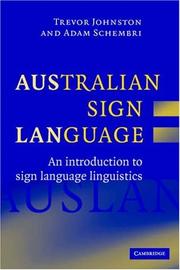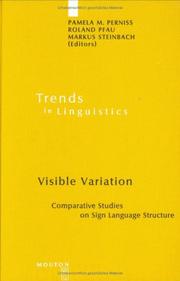| Listing 1 - 6 of 6 |
Sort by
|
Book
ISBN: 1316234592 131623648X 110728029X 1107051940 1107663865 Year: 2015 Publisher: Cambridge : Cambridge University Press,
Abstract | Keywords | Export | Availability | Bookmark
 Loading...
Loading...Choose an application
- Reference Manager
- EndNote
- RefWorks (Direct export to RefWorks)
How do people use sign languages in different situations around the world? How are sign languages distributed globally? What happens when they come in contact with spoken and written languages? These and other questions are explored in this new introduction to the sociolinguistics of sign languages and deaf communities. An international team brings insights and data from a wide range of sign languages, from the USA, Canada, England, Spain, Brazil and Australia. Topics covered include multilingualism in the global deaf community, sociolinguistic variation and change in sign languages, bilingualism and language contact between signed and spoken languages, attitudes towards sign languages, sign language planning and policy, and sign language discourse. Sociolinguistics and Deaf Communities will be welcomed by students of sign language and interpreting, teachers of sign language, and students and academics working in linguistics.
Sign language. --- Deaf --- Sociolinguistics. --- Language and languages --- Language and society --- Society and language --- Sociology of language --- Language and culture --- Linguistics --- Sociology --- Integrational linguistics (Oxford school) --- Gesture language --- Speech-reading --- Speechreading --- Communication --- Gesture --- Signs and symbols --- Means of communication. --- Social aspects --- Sociological aspects --- Education --- Speech --- Sign language
Multi
ISBN: 9781107280298 9781107051942 9781107663862 1316234592 131623648X 110728029X Year: 2015 Publisher: Cambridge Cambridge University Press
Abstract | Keywords | Export | Availability | Bookmark
 Loading...
Loading...Choose an application
- Reference Manager
- EndNote
- RefWorks (Direct export to RefWorks)
How do people use sign languages in different situations around the world? How are sign languages distributed globally? What happens when they come in contact with spoken and written languages? These and other questions are explored in this new introduction to the sociolinguistics of sign languages and deaf communities. An international team brings insights and data from a wide range of sign languages, from the USA, Canada, England, Spain, Brazil and Australia. Topics covered include multilingualism in the global deaf community, sociolinguistic variation and change in sign languages, bilingualism and language contact between signed and spoken languages, attitudes towards sign languages, sign language planning and policy, and sign language discourse. Sociolinguistics and Deaf Communities will be welcomed by students of sign language and interpreting, teachers of sign language, and students and academics working in linguistics.
Sociolinguistics --- Sign language --- Sign language. --- Deaf --- Sociolinguistics. --- Means of communication.

ISBN: 0521832977 9780521832977 0521540569 9780521540568 9780511607479 9780511566837 0511268807 9780511268809 0511266855 9780511266850 0511268130 9780511268137 9780511648854 0511648855 0511607474 1107160820 9781107160828 1316099253 9781316099254 0511566832 Year: 2007 Publisher: Cambridge, UK New York Cambridge University Press
Abstract | Keywords | Export | Availability | Bookmark
 Loading...
Loading...Choose an application
- Reference Manager
- EndNote
- RefWorks (Direct export to RefWorks)
This is first comprehensive introduction to the linguistics of Auslan, the sign language of Australia. Assuming no prior background in language study, it explores each key aspect of the structure of Auslan, providing an accessible overview of its grammar (how sentences are structured), phonology (the building blocks of signs), morphology (the structure of signs), lexicon (vocabulary), semantics (how meaning is created), and discourse (how Auslan is used in context). The authors also discuss a range of myths and misunderstandings about sign languages, provide an insight into the history and development of Auslan, and show how Auslan is related to other sign languages, such as those used in Britain, the USA and New Zealand. Complete with clear illustrations of the signs in use and useful further reading lists, this is an ideal resource for anyone interested in Auslan, as well as those seeking a clear, general introduction to sign language linguistics.
Australian Sign Language. --- Australian Sign Language --- #KVHA:Gebarentaal; Australië --- #KVHA:Taalkunde --- Auslan (Sign language) --- Sign language --- Sign language. --- Deaf --- Gesture language --- Language and languages --- Gesture --- Signs and symbols --- Arts and Humanities --- Language & Linguistics
Book
ISBN: 9781107663862 9781107051942 Year: 2015 Publisher: Cambridge Cambridge University Press
Abstract | Keywords | Export | Availability | Bookmark
 Loading...
Loading...Choose an application
- Reference Manager
- EndNote
- RefWorks (Direct export to RefWorks)
Book
ISBN: 094905013X Year: 2018 Publisher: Victoria : Deaf Australia Inc.,
Abstract | Keywords | Export | Availability | Bookmark
 Loading...
Loading...Choose an application
- Reference Manager
- EndNote
- RefWorks (Direct export to RefWorks)
Mini woordenboek Auslan, de Australische gebarentaal.


ISBN: 9783110198850 3110198851 9783110195781 311019578X 1282194593 9781282194595 9786612194597 6612194596 Year: 2008 Volume: 188 Publisher: Berlin Boston
Abstract | Keywords | Export | Availability | Bookmark
 Loading...
Loading...Choose an application
- Reference Manager
- EndNote
- RefWorks (Direct export to RefWorks)
It has been argued that properties of the visual-gestural modality impose a homogenizing effect on sign languages, leading to less structural variation in sign language structure as compared to spoken language structure. However, until recently, research on sign languages was limited to a number of (Western) sign languages. Before we can truly answer the question of whether modality effects do indeed cause less structural variation, it is necessary to investigate the similarities and differences that exist between sign languages in more detail and, especially, to include in this investigation less studied sign languages. The current research climate is testimony to a surge of interest in the study of a geographically more diverse range of sign languages. The volume reflects that climate and brings together work by scholars engaging in comparative sign linguistics research. The 11 articles discuss data from many different signed and spoken languages and cover a wide range of topics from different areas of grammar including phonology (word pictures), morphology (pronouns, negation, and auxiliaries), syntax (word order, interrogative clauses, auxiliaries, negation, and referential shift) and pragmatics (modal meaning and referential shift). In addition to this, the contributions address psycholinguistic issues, aspects of language change, and issues concerning data collection in sign languages, thereby providing methodological guidelines for further research. Although some papers use a specific theoretical framework for analyzing the data, the volume clearly focuses on empirical and descriptive aspects of sign language variation.
Sign language. --- Language and languages --- Psycholinguistics. --- Linguistic change. --- Langage par signes --- Variation (Linguistique) --- Psycholinguistique --- Changement linguistique --- Variation. --- linguistic typology. --- Linguistic change --- Psycholinguistics --- Sign language --- Variation
| Listing 1 - 6 of 6 |
Sort by
|

 Search
Search Feedback
Feedback About UniCat
About UniCat  Help
Help News
News